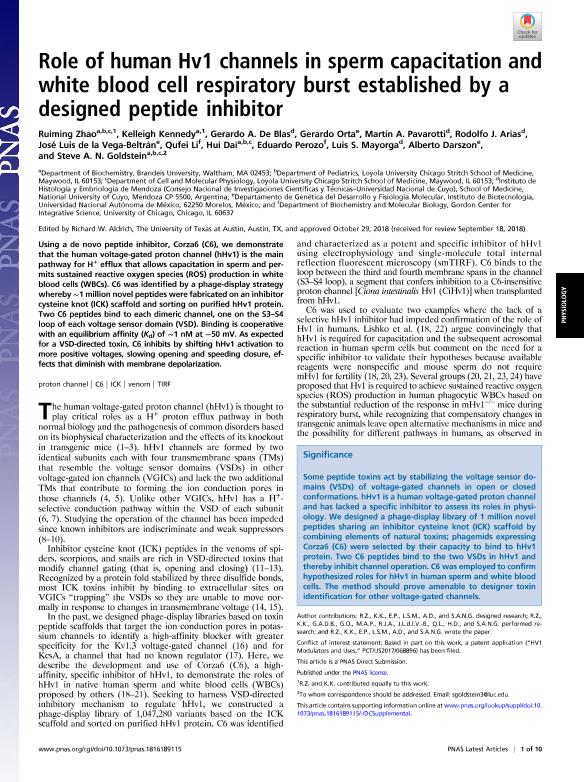Artículo
Role of human Hv1 channels in sperm capacitation and white blood cell respiratory burst established by a designed peptide inhibitor
Zhao, Ruiming; Kennedy, Kelleigh; de Blas, Gerardo Andrés ; Orta, Gerardo; Pavarotti, Martin Alejandro
; Orta, Gerardo; Pavarotti, Martin Alejandro ; Arias, Rodolfo José; de la Vega Beltrán, José Luis; Li, Qufei; Dai, Hui; Perozo, Eduardo; Mayorga, Luis Segundo
; Arias, Rodolfo José; de la Vega Beltrán, José Luis; Li, Qufei; Dai, Hui; Perozo, Eduardo; Mayorga, Luis Segundo ; Darszon, Alberto; Goldstein, Steve A. N.
; Darszon, Alberto; Goldstein, Steve A. N.
 ; Orta, Gerardo; Pavarotti, Martin Alejandro
; Orta, Gerardo; Pavarotti, Martin Alejandro ; Arias, Rodolfo José; de la Vega Beltrán, José Luis; Li, Qufei; Dai, Hui; Perozo, Eduardo; Mayorga, Luis Segundo
; Arias, Rodolfo José; de la Vega Beltrán, José Luis; Li, Qufei; Dai, Hui; Perozo, Eduardo; Mayorga, Luis Segundo ; Darszon, Alberto; Goldstein, Steve A. N.
; Darszon, Alberto; Goldstein, Steve A. N.
Fecha de publicación:
12/2018
Editorial:
National Academy of Sciences
Revista:
Proceedings of the National Academy of Sciences of The United States of America
ISSN:
0027-8424
Idioma:
Inglés
Tipo de recurso:
Artículo publicado
Clasificación temática:
Resumen
Using a de novo peptide inhibitor, Corza6 (C6), we demonstrate that the human voltage-gated proton channel (hHv1) is the main pathway for H+ efflux that allows capacitation in sperm and permits sustained reactive oxygen species (ROS) production in white blood cells (WBCs). C6 was identified by a phage-display strategy whereby ∼1 million novel peptides were fabricated on an inhibitor cysteine knot (ICK) scaffold and sorting on purified hHv1 protein. Two C6 peptides bind to each dimeric channel, one on the S3–S4 loop of each voltage sensor domain (VSD). Binding is cooperative with an equilibrium affinity (Kd) of ∼1 nM at −50 mV. As expected for a VSD-directed toxin, C6 inhibits by shifting hHv1 activation to more positive voltages, slowing opening and speeding closure, effects that diminish with membrane depolarization.
Palabras clave:
C6
,
ICK
,
PROTON CHANNEL
,
TIRF
,
VENOM
Archivos asociados
Licencia
Identificadores
Colecciones
Articulos(IHEM)
Articulos de INST. HISTOLOGIA Y EMBRIOLOGIA DE MEND DR.M.BURGOS
Articulos de INST. HISTOLOGIA Y EMBRIOLOGIA DE MEND DR.M.BURGOS
Citación
Zhao, Ruiming; Kennedy, Kelleigh; de Blas, Gerardo Andrés; Orta, Gerardo; Pavarotti, Martin Alejandro; et al.; Role of human Hv1 channels in sperm capacitation and white blood cell respiratory burst established by a designed peptide inhibitor; National Academy of Sciences; Proceedings of the National Academy of Sciences of The United States of America; 115; 50; 12-2018; E11847-E11856
Compartir
Altmétricas



